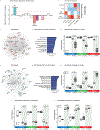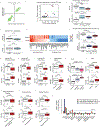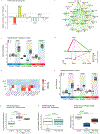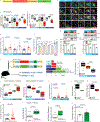Identification of evolutionarily conserved gene networks mediating neurodegenerative dementia
- PMID: 30510257
- PMCID: PMC6602064
- DOI: 10.1038/s41591-018-0223-3
Identification of evolutionarily conserved gene networks mediating neurodegenerative dementia
Abstract
Identifying the mechanisms through which genetic risk causes dementia is an imperative for new therapeutic development. Here, we apply a multistage, systems biology approach to elucidate the disease mechanisms in frontotemporal dementia. We identify two gene coexpression modules that are preserved in mice harboring mutations in MAPT, GRN and other dementia mutations on diverse genetic backgrounds. We bridge the species divide via integration with proteomic and transcriptomic data from the human brain to identify evolutionarily conserved, disease-relevant networks. We find that overexpression of miR-203, a hub of a putative regulatory microRNA (miRNA) module, recapitulates mRNA coexpression patterns associated with disease state and induces neuronal cell death, establishing this miRNA as a regulator of neurodegeneration. Using a database of drug-mediated gene expression changes, we identify small molecules that can normalize the disease-associated modules and validate this experimentally. Our results highlight the utility of an integrative, cross-species network approach to drug discovery.
Conflict of interest statement
Competing Financial Interests
D.H.G. has received research funding from Takeda Pharmaceutical Company Limited. K.N., H.T., A.O., K.H. and S.K. are employees of Takeda Pharmaceutical Company Limited.
Figures







References
-
- Iqbal K, Liu F & Gong C-X Tau and neurodegenerative disease: the story so far. Nature Reviews Neurology 12, 15–27 (2016). - PubMed
-
- Masters CL et al. Alzheimer’s disease. Nat Rev Dis Primers 1, 15056 (2015). - PubMed
-
- Kovacs GG Invited review: Neuropathology of tauopathies: principles and practice. Neuropathol Appl Neurobiol 41, 3–23 (2015). - PubMed
-
- Mullane K & Williams M Alzheimer’s therapeutics: continued clinical failures question the validity of the amyloid hypothesis-but what lies beyond? Biochem. Pharmacol 85, 289–305 (2013). - PubMed
Methods References
-
- Chishti MA et al. Early-onset amyloid deposition and cognitive deficits in transgenic mice expressing a double mutant form of amyloid precursor protein 695. Journal of Biological Chemistry 276, 21562–21570 (2001). - PubMed
-
- Matarin M et al. A Genome-wide Gene-Expression Analysis and Database in Transgenic Mice during Development of Amyloid or Tau Pathology. Cell Rep 10, 633–644 (2015). - PubMed
Publication types
MeSH terms
Substances
Grants and funding
- G1100540/MRC_/Medical Research Council/United Kingdom
- MC_UU_00024/1/MRC_/Medical Research Council/United Kingdom
- MC_U105597119/MRC_/Medical Research Council/United Kingdom
- G0900652/MRC_/Medical Research Council/United Kingdom
- MC_UU_00024/7/MRC_/Medical Research Council/United Kingdom
- MR/J009482/1/MRC_/Medical Research Council/United Kingdom
- U01 AG046139/AG/NIA NIH HHS/United States
- MC_UU_00005/12/MRC_/Medical Research Council/United Kingdom
- P01 AG017216/AG/NIA NIH HHS/United States
- R01 AG018023/AG/NIA NIH HHS/United States
- U01 AG006786/AG/NIA NIH HHS/United States
- MC_G1000734/MRC_/Medical Research Council/United Kingdom
- MC_U123192748/MRC_/Medical Research Council/United Kingdom
- P30 AG010124/AG/NIA NIH HHS/United States
- 203249/Z/16/Z/WT_/Wellcome Trust/United Kingdom
- MR/N012453/1/MRC_/Medical Research Council/United Kingdom
- R25 NS065723/NS/NINDS NIH HHS/United States
- P50 AG016574/AG/NIA NIH HHS/United States
- P01 AG017586/AG/NIA NIH HHS/United States
- P01 AG003991/AG/NIA NIH HHS/United States
- P50 AG005681/AG/NIA NIH HHS/United States
- P01 AG019724/AG/NIA NIH HHS/United States
- G0502157/MRC_/Medical Research Council/United Kingdom
- G0301152/MRC_/Medical Research Council/United Kingdom
- R01 AG032990/AG/NIA NIH HHS/United States
- R01 NS080820/NS/NINDS NIH HHS/United States
- G0400074/MRC_/Medical Research Council/United Kingdom
- P01 AG003949/AG/NIA NIH HHS/United States
- U24 NS072026/NS/NINDS NIH HHS/United States
- U01 AG046161/AG/NIA NIH HHS/United States
- P30 AG019610/AG/NIA NIH HHS/United States
- P50 AG025711/AG/NIA NIH HHS/United States
LinkOut - more resources
Full Text Sources
Other Literature Sources
Medical
Molecular Biology Databases
Miscellaneous

